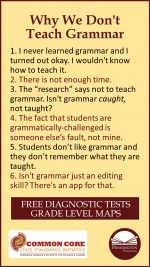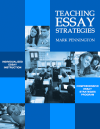Grammar Instruction: Establishing Common Ground
Perhaps no instructional issue in English-language arts produces more contentious debate than the issue of how best to teach grammar. When most of us refer to grammar we mean the structure of the sentence, the components of the sentence, word choice, the order of words, style, and usage. Some will also include punctuation, capitalization and even, perhaps spelling in the grammar stew.
All too often we bog down in our discussion over the issue of instructional strategies. Should we teach these skills explicitly through direct instruction? Should we teach these skills implicitly at the point of student need? Should we teach these skills in isolation? Should we teach these skills in the context of writing? What are the most efficient and effective means of instruction? Which instructional strategies produce the most retention? How can we differentiate instruction?
It may be that we begin, but quickly end the discussion of how to teach grammar because in posing these questions we are placing the “cart before the horse.” Perhaps a more useful starting point for our discussion would be to come to consensus about what we expect students to know and when. Establishing a common ground on this issue can help us determine what to diagnostically assess in order to determine our students’ relative strengths and weaknesses. Only at this point does it make sense to discuss the instructional strategies that will address the needs of our students.
This goal of consensus can be easier said than done. Teachers are inherently protective of their own instructional sovereignty. We all enter teaching to be “queens and kings of our own castles.” We are, by nature, independent thinkers. Collaboration requires some levels of releasing that sovereignty and replacing some of that independence with dependence. Additionally, we are all afraid of exposing our deficiencies. Many of us have received little grammar instruction and less training in how to teach the skills outlined above. Colleagues can be intimidating. It’s hard to admit our weaknesses. Much easier to keep our ostrich heads in the sand regarding grammar and focus our efforts on what we do know.
However, for the sake of our students we need to acknowledge our “elephants” in the room and begin to trust our colleagues. A climate of collaboration can be nurtured among teaching professionals. This risk-taking climate takes time and requires sensitive leadership. Group norms need to be established and practiced to ensure success. But, the results will be worth the efforts.
What Should Students Know and When?
At first blush, teachers will latch onto to Common Core Language Strand Standards. Fine as a starting point and undoubtedly more rigorous than previous state standards which tended to emphasize grammar, usage, and mechanics instruction only in the writing context; however, standards only offer a basic blueprint for grammatical instruction. The devil is in the details. Defining these issues in meaningful ways that will impact both instruction and learning necessitates detailed conversations. We need to get specific.
It makes sense to establish a set of skills and expectations to be mastered at each grade level. Defining a specific year-to-year instructional scope and sequence (the Common Core Standards are far too generic) with colleagues provides a game plan and also defines the content for assessment. See the following author tag for a comprehensive instructional scope and sequence for Grades 4-8. These skills and expectations need to be hammered out in the context of vertical teaming and articulation. The complexity of English grammar and the recursive nature of grammatical instruction necessitate grade-to-grade level discussion and consensus-building.
At my middle school, we began the conversation with seventh and eighth grade teams. We then got release time to meet with our elementary and high school colleagues. We began the process of building a scope and sequence to help us move students from Point A to Point B to Point C. Our goals were to adopt a common academic language, establish grade-level expectations, and build in review to address the recursive nature of grammatical instruction. We found much more common ground on these goals than many of us had expected, especially because we have not addressed instructional strategies at this point of the conversation.
How Do We Know What They Know and Do Not Know?
Having agreed to 72 skills and expectations for our middle schoolers in our comprehensive instructional scope and sequence, we then began designing diagnostic assessments to inform our grammatical instruction. Our criteria for the diagnostic assessments included the following: The assessments must specifically focus on the 72 “common ground” components of our instructional scope and sequence. The assessments must be whole-class, easy-to-administer, easy-to-grade, and easy-to-record. The assessment components should be “teachable.” One such set of diagnostic assessments, based upon 72 “common ground issues” that we are using as starting points are my own multiple-choice Grammar and Mechanics Assessments.
Where Do We Go from Here?
Having established what students need to know and when, and having developed diagnostic assessments to determine what students do and do not know, the real fun begins. At this point, we are beginning the process of sharing the instructional strategies that seem to best meet the needs of our students. Explicit or implicit instructional strategies? How can we establish benchmarks to formatively assess skill acquisition? How can we differentiate instruction, according to the results of our assessments?
*****

Pennington Publishing Grammar Programs
Teaching Grammar, Usage, and Mechanics (Grades 4, 5, 6, 7, 8, and High School) are full-year, traditional, grade-level grammar, usage, and mechanics programs with plenty of remedial practice to help students catch up while they keep up with grade-level standards. Twice-per-week, 30-minute, no prep lessons in print or interactive Google slides with a fun secret agent theme. Simple sentence diagrams, mentor texts, video lessons, sentence dictations. Plenty of practice in the writing context. Includes biweekly tests and a final exam.
Grammar, Usage, and Mechanics Interactive Notebook (Grades 4‒8) is a full-year, no prep interactive notebook without all the mess. Twice-per-week, 30-minute, no prep grammar, usage, and mechanics lessons, formatted in Cornell Notes with cartoon response, writing application, 3D graphic organizers (easy cut and paste foldables), and great resource links. No need to create a teacher INB for student make-up work—it’s done for you! Plus, get remedial worksheets, biweekly tests, and a final exam.
Syntax in Reading and Writing is a function-based, sentence-level syntax program, designed to build reading comprehension and increase writing sophistication. The 18 parts of speech, phrases, and clauses lessons are each leveled from basic (elementary) to advanced (middle and high school) and feature 5 lesson components (10–15 minutes each): 1. Learn It! 2. Identify It! 3. Explain It! (analysis of challenging sentences) 4. Revise It! (kernel sentences, sentence expansion, syntactic manipulation) 5. Create It! (Short writing application with the syntactic focus in different genre).
Get the Diagnostic Grammar, Usage, and Mechanics Assessments, Matrix, and Final Exam FREE Resource:
![]()








